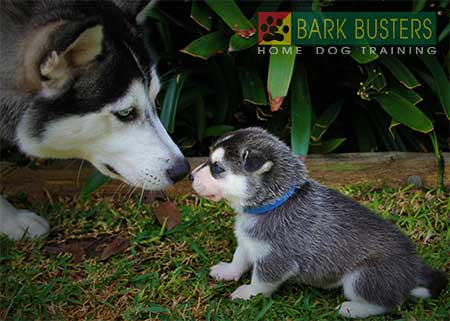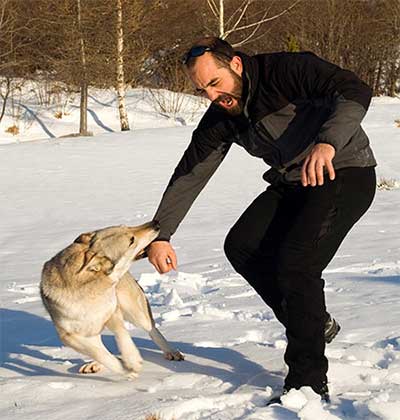Introducing a new puppy or dog
 If you have decided that the time is right to add a new dog to your family, you will probably be feeling really excited to introduce the new addition to the rest of the family. There will be reasons why you felt that this was the right dog for your family…right age, right size, right temperament, good with children, good with other dogs etc., so you are confident that this new dog will easily slot in to your family group.
If you have decided that the time is right to add a new dog to your family, you will probably be feeling really excited to introduce the new addition to the rest of the family. There will be reasons why you felt that this was the right dog for your family…right age, right size, right temperament, good with children, good with other dogs etc., so you are confident that this new dog will easily slot in to your family group.Whether you have decided on a puppy, or an adult dog, you should take time to consider that your resident dogs may not be quite as excited as you are about the prospect of a new dog moving in. In fact, this change in the family group can prove quite stressful for your dog, so it’s worth taking care to manage the introduction and so minimise potential problems.
We’ve put together a few tips to help you:
If you are adopting from a dog rescue centre most rescues will ask you to bring your existing dog to the centre where you can all meet your potential adoptee. The staff, and you, will then be able to see how the dogs interact with each other before agreeing that you should take your new dog home. Even if you aren’t adopting through a rescue centre, it is still a good idea to allow the dogs to meet on neutral territory first, as your dog may react to a new, unknown, dog arriving on his territory. Also, if you already have more than one dog, it’s worth introducing them singularly to the new dog so that you don’t overwhelm the new dog with an already established group.
Once in your home, ensure that the new dog has its own sleeping area, and its own food bowl. Don’t expect your existing dog to be willing to share its bed or food bowl with the newcomer. Feed the dogs in separated areas, and remove food bowls after each meal time as dogs can be possessive over food bowls even when empty.
Use a crate or safety gate to ensure separation. Allow your existing dog to roam freely, but secure the new dog. This gives the existing dog time to get used to the new dog being there, and to accept that he has not lost his place in the family group.
Never leave new your new dog unattended with your existing dog until the dogs have got to know one another, as the situation can sometimes deteriorate quickly. At times when you do allow the dogs together in one room, make sure you are on hand to deal with any issues as the situation can change very quickly. Also ensure that any prized possessions and toys are removed so that these don’t cause any sort of potential rivalry. The dogs should have their own toys that are only brought out for them to play with when they are separated.
Always remember that your existing dog needs to be confident in his status and where he fits within your family group in order to accept the newcomer. Treat him the same way as you always have done, and be fair about sharing your attention. In fact, share everything equally, including your time and attention, as well as treats and toys. Never favour your new dog over your existing dog. Your new dog will learn a lot from your existing dog about how the household works, so doing your utmost to maintain routines will help both of them as they adapt to each other.
Introducing a puppy to an adult dog.
Not all dogs will welcome a new puppy into the home. Puppies are notorious in looking for attention and can easily overwhelm your existing dog. Supervision is needed when introducing so as not to get them off on the wrong foot.
Very young puppies may not understand and pick up on your existing dogs body language that says he's had enough. A well-balanced adult dog may growl to tell the puppy to back off and to say he's had enough. This can be a natural behaviour and establishes the ground rules and helps the puppy learn the boundaries. However, an adult dog with poor social skills may not growl and can snap out and harm the puppy. Try to observe the body language of your existing dog and if the situation looks to be uncomfortable remove the puppy for a period of time. Don't leave your dog and puppy unsupervised and unattended. Be mindful and respect your existing dog's need for a puppy free time and also spend some one-on-one time with your existing dog too.
Handle the puppy-to-dog introduction with care as you would when you introduce two adult dogs. Observe their body language, allow brief sniffs, ensure they don't overwhelm each other and place them on leads if you feel it's safer. Don't forget to praise them when they are calm and they are well behaved.
Bark Busters trainers have trained more than 1 Million dogs worldwide and are renowned authorities in addressing dog behaviour with all-natural, dog-friendly methods. Bark Busters training is the only service of its kind that offers International guaranteed lifetime support. With hundreds of trainers around the world, Bark Busters continues its mission to enhance the human/canine relationship and to reduce the possibility of maltreatment, abandonment and euthanasia. Contact your local Bark Busters dog trainer to see how they can help.

 Dog bite prevention week takes place on the third week of May annually and aims to educate people in how to avoid being bitten by a dog. It's a sad fact that dog bites, in the UK, increase more and more each year. Over the past 10 years, dog bites have increased by over 40%. The latest NHS figures appear to show that there has been an increase of over 6% on 2014 compared to 2013*.
Dog bite prevention week takes place on the third week of May annually and aims to educate people in how to avoid being bitten by a dog. It's a sad fact that dog bites, in the UK, increase more and more each year. Over the past 10 years, dog bites have increased by over 40%. The latest NHS figures appear to show that there has been an increase of over 6% on 2014 compared to 2013*.